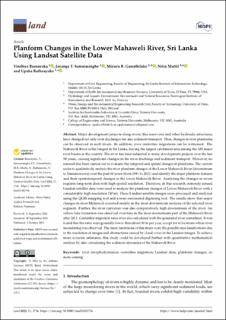| dc.contributor.author | Basnayaka, Vindhya | |
| dc.contributor.author | Samarasinghe, Jayanga T. | |
| dc.contributor.author | Gunathilake, Miyuru | |
| dc.contributor.author | Muttil, Nitin | |
| dc.contributor.author | Rathnayake, Upaka | |
| dc.date.accessioned | 2023-01-11T09:32:20Z | |
| dc.date.available | 2023-01-11T09:32:20Z | |
| dc.date.created | 2022-11-29T08:16:26Z | |
| dc.date.issued | 2022-10-03 | |
| dc.identifier.citation | Land. 2022, 11 (10), 1-16. | en_US |
| dc.identifier.issn | 2073-445X | |
| dc.identifier.uri | https://hdl.handle.net/11250/3042601 | |
| dc.description.abstract | Major development projects along rivers, like reservoirs and other hydraulic structures, have changed not only river discharges but also sediment transport. Thus, changes in river planforms can be observed in such rivers. In addition, river centerline migrations can be witnessed. The Mahaweli River is the longest in Sri Lanka, having the largest catchment area among the 103 major river basins in the country. The river has been subjected to many development projects over the last 50 years, causing significant changes in the river discharge and sediment transport. However, no research has been carried out to evaluate the temporal and spatial changes in planforms. The current seeks to qualitatively analyze the river planform changes of the Lower Mahaweli River (downstream to Damanewewa) over the past 30 years (from 1991 to 2021) and identify the major planform features and their spatiotemporal changes in the lower Mahaweli River. Analyzing the changes in rivers requires long-term data with high spatial resolution. Therefore, in this research, remotely sensed Landsat satellite data were used to analyze the planform changes of Lower Mahaweli River with a considerably high resolution (30 m). These Landsat satellite images were processed and analyzed using the QGIS mapping tool and a semi-automated digitizing tool. The results show that major changes in river Mahaweli occurred mainly in the most downstream sections of the selected river segment. Further, the river curvature was also comparatively high downstream of the river. An oxbow lake formation was observed over time in the most downstream part of the Mahaweli River after 2011. Centerline migration rates were also calculated with the generated river centerlines. It was found that the rates were generally lower than about 30 m per year, except for at locations where river meandering was observed. The main limitations of this study were the possible misclassifications due to the resolution of images and obstructions caused by cloud cover in the Landsat images. To achieve more accurate estimates, this study could be developed further with quantitative mathematical analysis by also considering the sediment dynamics of the Mahaweli River. | en_US |
| dc.language.iso | eng | en_US |
| dc.publisher | MDPI | en_US |
| dc.rights | Navngivelse 4.0 Internasjonal | * |
| dc.rights.uri | http://creativecommons.org/licenses/by/4.0/deed.no | * |
| dc.title | Planform Changes in the Lower Mahaweli River, Sri Lanka Using Landsat Satellite Data | en_US |
| dc.title.alternative | Planform Changes in the Lower Mahaweli River, Sri Lanka Using Landsat Satellite Data | en_US |
| dc.type | Peer reviewed | en_US |
| dc.type | Journal article | en_US |
| dc.description.version | publishedVersion | en_US |
| dc.rights.holder | © 2022 by the authors | en_US |
| dc.source.pagenumber | 1-16 | en_US |
| dc.source.volume | 11 | en_US |
| dc.source.journal | Land | en_US |
| dc.source.issue | 10 | en_US |
| dc.identifier.doi | 10.3390/land11101716 | |
| dc.identifier.cristin | 2083314 | |
| dc.source.articlenumber | 1716 | en_US |
| cristin.ispublished | true | |
| cristin.fulltext | original | |
| cristin.qualitycode | 1 | |

